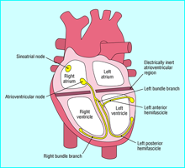Interventional Pediatric Cardiology
- Best ASD Device Closure in Delhi
- Best VSD Device Closure in Delhi
- Best PDA Device Closure in Delhi
- Management of Ruptured Sinus of Valsalva (Device Closure of RSOV)
- Coronary Fistula Device Closure in Delhi
- Balloon Pulmonary Valvuloplasty
- Balloon Aortic Valvuloplasty
- PDA Stenting in New born in Delhi
- PA Stenting in Children in Delhi
- Balloon Atrial Septostomy (BAS)
- Coarctation of Aorta Stenting in Children
- Interatrial Septal Stenting (IAS Stenting)
- Pericardiocentesis
- Coarctation of Aorta Balloon Dilation
- Coil Closure of Collaterals
Supraventricular tachycardia (SVT) is the most common heart rhythm disorder in pediatric age group including healthy newborn and infants.
SVTs are often having a tendency of recurrence, rarely life threating.
A normal heartbeat originates in the sinus node in right atrium (RA) and that travels through the heart tissues to all parts of the heart in a regular and sequential method (as shown in the diagram).
In cases of SVTs, there is occurrence of rapid and abnormal beats in the right atrium that increases the heart beat and can leads to decreased blood flow to the lower chambers of the heart leading to poor blood supply to the body parts and child can presents in shock like state (cardiogenic shock).
Causes of SVT in children
- Idiopathic: When no cause is identified
- Accessory pathway SVT (AVRT/AVNRT) including WPW syndrome (pre-excitation)
Symptoms due to SVT in children
This may include:
- Feeling of own heart beat known as palpitations (increased heart beat)
- Child may tell that these rapid heartbeats occurs suddenly and stops suddenly
- Feeling of chest pain due to rapid heart beats
- Feeling of fainting or syncope
- Signs of cardiac failure like tiredness, rapid and difficult breathing, poor feeding etc
- Newborns generally presents in the form of excessive cry, poor feeding, vomiting and signs of heart failure including shock like state.
- Vary rarely, death can occur
Diagnosis of SVT in children
- It can be suspected by counting the heart rates and can be confirmed by doing ECG/EKG if taken at the time of SVT episode. ECG is a non-invasive test and is done from the chest of the child. It helps in assessing the heart rate, heart rhythm etc.
- But if ECG is not conclusive, then we can plan Holter test analysis in which we put a machine on the chest of the child and then sent back the child to home for next 24 hours and is being advised to do all routing activities that child perform on daily basis (not to do bed rest).
- Rarely, we need to perform treadmill test (TMT) test for analyzing the SVT. In this, child is being allowed to walk and run on treadmill machine and then need to assess heart rate and various types of cardiac rhythm and blood pressure related issues. This test can be done on OPD basis. In this test, we continuously watch on ECG in monitor as well as monitor blood pressure changes.
- Echocardiography can be done when we suspect some form of heart defects (CHDs) but need not to be done in every children.
SVT treatment in children
Treatment options are as follows:
Vagal maneuvers: can be performed in older kids. It can be done in the form of Valsalva maneuver, by immersing face in ice-cold water (diving reflex) or by coughing
Medication for SVT
When SVT does not respond to vagal maneuvers, medicines are to be used for controlling the heart rates.
B blockers, Calcium channel blockers, digoxin, Amiodarone are the commonly used drugs in pediatric age group.
RF Ablation
When medicines are ineffective, RF ablation is the treatment of choice.
It is done in cath lab by angiographic technique. This leads to complete resolution of SVT in children.


